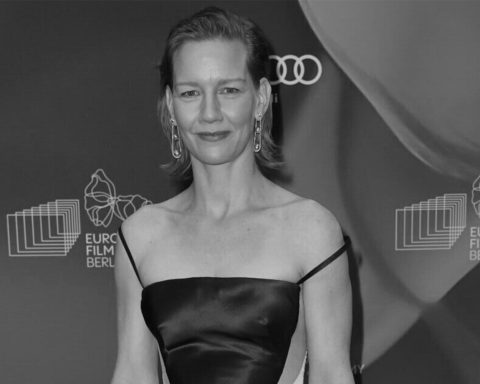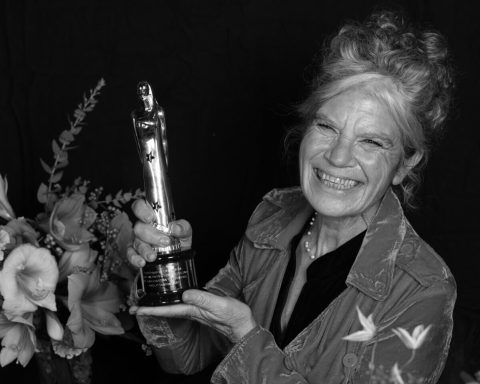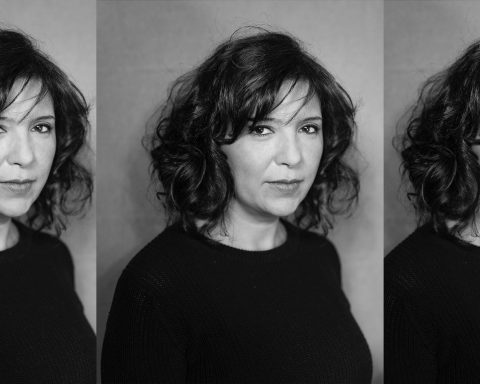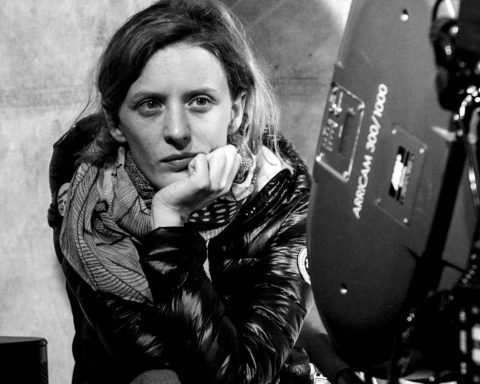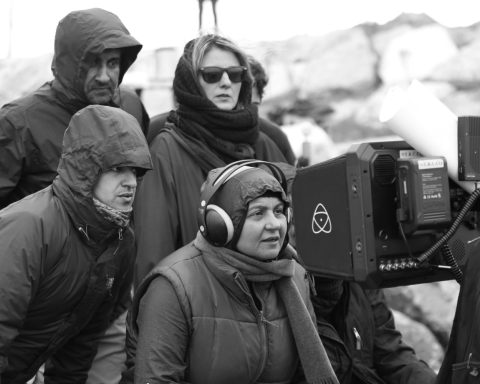Neasa Hardiman’s multiple degrees include a Master’s in Visual Communication from Berlin’s Universität der Künste and a PhD in Film Studies from Dublin’s Trinity College. She made documentaries with RTÉ before directing numerous dramas with the BBC, including her BAFTA-winning “Happy Valley,” then moved to work in the US on high-end dramas including Amazon’s “Z: The Beginning of Everything,” Marvel / Netflix’s“Jessica Jones,” and upcoming Netflix international mystery thriller “Hit and Run.”
Her debut feature, “Sea Fever,” premiered on the opening night of the 2019 Toronto International Film Festival to rave reviews. It tells the story of Siobhan, a solitary marine biology student doing eco-research on a trawler, who faces the challenge of her life when an unfathomable animal ensnares the boat.
How did Sea Fever come about? Why did you choose this particular story for your first feature?
N.H.: I’m Irish. We are a very verbal culture and it’s important to be able to tell a good story in Ireland, but we don’t have as resonant a history of visual culture, and we don’t have a very populous community of formally innovative, visually-driven filmmakers. But that was the area that I really wanted this film to live in, that area where all aspects of cinema combine to mobilize emotion, to say something truthful through cinematic metaphor.
In terms of the thematic, I wanted to tell a story that was about the conflict between individual need and global need. The story probes questions about the ethics of protecting ourselves versus protecting others. In that context, I wanted to explore a prominent ideology purporting that there’s no such thing as society, that we’re all just atomized individuals in competition with one another. The climate crisis is rooted very strongly in this misrecognizing ourselves as existing outside of community. We misrecognize ourselves as outside of our community, just like we misrecognize ourselves as outside of our biosphere, rather than understanding ourselves as a dynamic and integrated part of our families, our communities, and our broader world. No man is an island, as Donne says.
Exactly. There is a lot of discussion regarding the genre of the film. Some say it’s a horror film, some say it’s an eco-thriller. Where do you stand?
N.H.: I don’t think it’s a horror film. People who come to it looking for a horror film tend to be disappointed, because it doesn’t offer jump scares or the pleasures of defeating the monster. That’s not what it is. The American distributor told me that they were going to promote it as a psychological thriller. I think that’s more appropriate. I describe it as an eco-thriller with a sci-fi element, because it’s a tense, propulsive story, but it’s slow-burn. It’s a story that’s representational and metaphorical. It deals in unease, or the uncanny, more than in straight horror. When I was about twelve, I saw Neil Jordan’s The Company of Wolves. I was struck by the fact that it’s a film about grown-up ideas; sophisticated in terms of its thinking, but using the primal visual language of dreams.
Did you do some research about the trawler, fishing and maritime biology? Did you spend time on a trawler? Did you have an advisor?
N.H.: The kind of fishing that you get along Europe’s Atlantic seaboard is a broad community who know each other, because they all fish in the same waters. They all know each other, they all marry each other and are all connected. There is something quite beautiful about that in a world that is increasingly obsessed with borders and nations. Here’s a community of people who speak Icelandic, Swedish, Norwegian, Irish, Danish, English, Farsi and Arabic and they connect with each other as a family. But those communities are in crisis because of the way that large scale industry has come in and hoovered up traditional fishing grounds, so more boats like the one in the story are forced into fishing into deeper and more dangerous waters in order to make a living. Those people are financially very precarious. In the film, they come across another boat that’s bottom trawling, which is really destructive of the environment. They know it’s destructive and they know it’s the wrong thing to do but, at the same time, if you are in crisis and you need to food on the table for your own children, it can be pretty limiting in terms of what other options are available to you. So, I wanted to articulate clearly that part of what’s driving the ecological crisis is an economic crisis disproportionately affecting the poorest people.
I got in touch with the captain of the fishing trawler, which is the trawler that’s in the film, and she very kindly went through the story with me and gave me some great tips about what you would do if you actually wanted to kill the engine of a boat, the way people relate to each other, and the kinds of accidents that happen. One of the things that I referenced in the film is that she’s a native Irish speaker who’s married to an Icelandic guy. It was really important to me to reflect those inter-country connections.
The other body of research I undertook was on the animal. Everything the animal does in the story is rooted in truth. The animal’s an amalgam of the habits and systems of a number of real-life forms, and its reproductive system does make real sense. It’s an imaginary animal, because it’s a dreamlike element, it’s producing that kind of Verfremdungseffekt. But it is rooted in real cnideria, it’s a large-scale jelly fish.
I wanted to have an animal that was truthful in the design of its body, but that could not be anthropomorphized. There’s no face, there’s nothing you can look at and go: “I read an expression in that.” There’s an emptiness at the heart of it that’s unknowable. I think it’s Wittgenstein who says: “Even if we could speak to lions, we wouldn’t understand what they were saying.” It’s that idea that this is another life form, so why would you imagine that you can understand what it’s feeling or thinking? I wanted to have tendrils in the way that jelly fish have tendrils. There’s something quite beautiful and elegant about them. They almost feel like neurons that are reaching out to explore the world. I wanted it to be beautiful because it’s a metaphor for the unknowability of the environment. It needed to have scale and be mesmeric. So, it has this kind of iridescence and bioluminescence that’s truthful to the environment that it lives in and the kind of animals that it’s related to. But that gives it this quality of both awe and uncanniness.
Did you film on the boat?
N.H.: Yes. That was hard! It’s a film that we made for just over two million Euros and we filmed at sea. What was I thinking?!
Some scenes were shot on lots and in a studio, right?
N.H.: I filmed on the trawler, which is the trawler that belongs to the woman who advised on the story. It’s a real working trawler. Originally, I thought I’d film everything on the boat, so that it has authenticity. But when I went below deck, I realized space is at such a premium, we wouldn’t be able to get the gear down. So, we rebuilt the interior of the boat as a studio set. I specified color and spatial values, so we could articulate the claustrophobia of being locked into this space. The set was such that the actors could climb up and down the ladders and they could move through the space. It gave me the opportunity to remove walls and bits of floor as necessary so the camera is always inside the boat in the same way that the actors are, but the body of the camera and the eighty hairy guys who are necessary in order to make the film can all be outside of the structure of the boat. It’s left to the actors to use that space as if they were really at sea. We shot the sub aqua scenes in a tank.
You tap into the trope of untrustworthy scientist and magical thinking in Sea Fever. Can you elaborate on that?
N.H.: One of the central themes of the story is the conflict between magical thinking and reason and the scientific method. I wanted to unearth the roots of and destroy a trope that is very common in this kind of cinema, which is that the scientist isn’t trustworthy, that the scientific method is somehow rooted in narcissism or egoism and that the scientist is a figure who lacks a moral center. I wanted to reframe that in two different ways. I wanted to link it up to questions of magical thinking, and I wanted to create a hero scientist who is the most ethical, most courageous person on board, to reframe that trope. At the same time, I wanted to unearth the roots of that cliché scientist figure, which I believe are in misrepresentations of neurodivergence. Sometimes people who are cognitively divergent are drawn to the sciences because it’s an area of human endeavor where it’s possible to really contribute. So, at the beginning of this story, Siobhan is living a painful experience – being misread, misunderstood and seen as confrontational or unpleasant. She just withdraws as a result. But as the story progresses, she finds a way out of that withdrawal. She finds a way to connect and communicate. By the end of the story, she and Omid – who is a neurotypical scientist –are deeply connected and have a full, resolved, human relationship.
Siobhan’s rational thinking is very valuable in the story. But I also wanted to articulate the value of magical thinking. The boat is called Niamh Cínn Óir. She’s a very famous immortal figure from Irish mythology who falls in love with a mortal human. Her story, as is often the way with these things, is connected sometimes with natural phenomena like bioluminescence in the water. I wanted to show that the Danish captain of the boat, Freya, connects the loss of her child with this nebulous idea of Niamh Cínn Óir, with this idea that there’s something greater than us out there, making its presence felt through these beautiful, natural events. Freya’s nourished, reassured and comforted by her magical thinking that her daughter travels with her as she travels through these uncertain waters. There’s something very human and valuable about that. I wanted to underscore that in the film, to say that magical thinking can be wonderful and nourishing and contains a form of poetic truth.
Then at the story’s end, Siobhan, who’s at the other end of the spectrum where everything is very concrete, material and literal, she moves into that space where she becomes a classic mythical hero through her final act of courage and selflessness. In that moment, she becomes no longer just her material self, but also an immortal, mythical figure.
Can you talk about the red hair omen?
N.H.: The other thing that’s important about magical thinking, especially on trawlers, is that they are really superstitious, those guys. And the reason they are superstitious is because a lot of what they do, they’ve no control over. They’ve no control over the weather; they’ve no control over the catch. So, they do all these things that give the illusion of control, like knocking on wood and throwing salt over their shoulder, or not wearing green on a boat. Red hair is one of those things. I think that we all do that to a certain degree in moments where we feel we don’t have control. We might recite something to ourselves or knock on wood. The thing about red hair is a real superstition that you get on the boats. But they’re not going to throw anyone overboard because of it. They’re not stupid, they’re intelligent, thoughtful people going: “We would really rather obey these rules, but we understand the rules are a bit mad, so we’re not going to push it.”
Interestingly, one of the reviewers said: “There’s a moment in the story that says red hair’s unlucky on a boat – good luck with that in Ireland!” As if I’d made it up! But it’s true! In fact, there are relatively few red-haired people in Ireland. Red hair is unusual here. Mostly, ethnic Irish have blue eyes, dark hair and a complete inability to tan. Do you know where there are more redheads than anywhere else in the world? Scandinavia. Now, I don’t know if this is true, but I heard this from a University folklorist. The reason that red hair on a boat is unlucky in Ireland is because in the Middle Ages, the Vikings would raid Irish coastal settlements. They would steal everything and set fire to the houses. So, if you, were Irish, and you saw a redheaded person coming toward you on a boat, you’d run! And that’s where the superstition comes from.
As you’ve mentioned earlier, the film about individual need vs global need. Isn’t that timely now? But I know this wasn’t your intention when you were making the film.
N.H.: Obviously, Covid-19 wasn’t at all what we were thinking when we made the film; we were thinking about climate crisis. But when you put a community under pressure, you discover the cracks, you discover where the weak points are. So, we put this community under pressure to show the cracks and the cracks were economic versus ecological need. The cracks were in the fact that we’ve been sold the illusion there’s no such thing as society, it’s every man or woman for herself, we’re all in competition. And what I wanted the film to do was to say: “Look how this is not true.” Because in a moment where the whole community is threatened, my loss is your loss, and we’re in this together. What I wanted to do in the story was to say: “We have to work together to survive and I have to take responsibility for you and for your child and you have to take responsibility for me and for my child if any of us is going to live through this.” And that worked for climate crisis, but, of course, it works for any big threat. So, it’s a coincidence, of course, that the film was released during the Covid-19 pandemic, but it’s also kind of not. It wouldn’t matter what big threat it was; it would still feel resonant because that’s the thing that we’re struggling with – this ridiculous ideology that, somehow, we’re in competition with each other rather than being deeply connected.
Exactly and on that note – I don’t know if you agree, but there’s no villain in this story.
N.H.: Thank you!
I don’t see the creature as the villain; I see it rather as the result of the climate crisis.
N.H.: A hundred percent! And I put it into the story, but too subtly, I think, because I don’t think anybody picked it up! The only other boat has been bottom trawling, they have been doing this thing where they disrupted the really deep biosphere that had never been disrupted before. They were doing it because they needed the catch. What I really wanted to show was that everybody has their reasons. The third act of films like this often runs as a chase, a fight, a confrontation, then kill the monster. When I came to write the third act of this film, I really didn’t want to do that. It was important because it was Siobhan’s story. Her character meant the story had to become about how we all join hands, even inter-species, and protect each other, because we all just want to survive.
The soundscape of the film is very unsettling and adds another layer to the images, with the sounds, the creeks and groans and, in all of this, the boat is also a character in itself.
N.H.: Having been out on the trawler, one of the things that really struck me was how unsettling the soundscape is. The boat is making noise all the time. You can hear the water. You can hear things outside of the boat. There’s this odd sense that’s both claustrophobic and agoraphobic at the same time; you feel that you’re stuck in this thing and you also feel the huge, unknowable space outside where all kinds of things are happening that you’re not privy to, it’s not your world. So, we really wanted to reproduce that, and to have that sense that the boat is all around you, creaking and groaning.
Are you a feminist, and if so, how does it inform your filmmaking?
N.H.: Yes! It informs my filmmaking. I am interested in the idea that the ship of humanity requires all hands on deck to right itself. How much melanin you have in your skin, and how you wear your gonads, these things are not determinants of character, skillset or predisposition. I think it’s important that we tell stories about racial injustice and that we tell stories about sex-based injustice. And alongside those stories, I also think it’s really important that we tell stories where women and people of color are the heroes and have big lives, where they are not defined or confined by their sex or by their ethnicity. I think that both sets of stories have to happen simultaneously.
There’s a brilliant theorist called Helen Tiffin who says: “If we only ever tell stories about the ways in which we are culturally restricted, that in itself is a cultural restriction.” And I think that’s true. So, one of the things that I want to do with my storytelling is to tell stories about women that are about women doing their jobs, being fully human and not being impeded by anybody else’s stupid ideas of what a woman should be, because it’s dull and it’s boring and we get enough of it already.
What subjects interest you and that you would like to tackle in your work in the future? What would you like your audiences to come away with after watching your films?
N.H.: I don’t want to teach anybody anything, but I think as a viewer, what I like is the opportunity to see the world from another perspective. That’s what I try to deliver in screen stories; let’s just walk in somebody else’s shoes for a while, let’s see what that feels like. Let’s take the risks that we might be afraid to take in our own lives, or let’s take metaphorical risks. So, it’s seeing the world from another point of view. I think that when we do that as filmmakers, we are genuinely mobilizing the audience’s emotion. That could be transformative. That seems to be our job. We make culture. We make mythologies. And we have to take responsibility when we do that. We have to tell stories that are of our time. And we have to tell stories that contain things that we believe to be true, however scary or dangerous that is. We have to tell the truth in our stories.
That is absolutely true! On another note, who is your favorite female filmmaker and your favorite film by a female filmmaker?
N.H.: I have so many favorite female filmmakers. I’m sure you do too! Right now, I love Céline Sciamma’s film Portrait of a Lady on Fire. I love all her films, but her last film is such a masterpiece. I feel like she’s done that thing of making every part of the film speak to the essence of what that film is about. Everything from the cinematography to the design, to the costumes, to the performances, to the narrative. It’s an amazing piece about creative practice, about making culture through creative practice. Then there are Claire Denis and Agnieszka Holland. Kathryn Bigelow, obviously. The greatest formalist of our time and somebody who can conjure tension and unease like no other director I know. Not just the pair of war films she made, both of which are extraordinary, but also Detroit, which is a masterclass in unease and a masterclass in storytelling – that’s creating culture. She anticipated this cultural moment in Detroit, and did it with insight and intelligence. I also loved A Girl Walks Home Alone at Night by Ana Lily Amirpour, that was terrific. Atlantiques by Mati Diop – that’s a great film. I am Not a Witch by Rungano Nyoni – that’s a terrific film. I also love noir: Ida Lupino, Dorothy Arzner… So many women filmmakers.
What are your next projects?
N.H.: Well, burning question of the moment! I am hoping to make a grounded sci-fi thriller, so I’m in process on that at the moment.
This interview was conducted in partnership with:

and:







